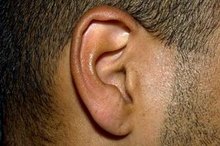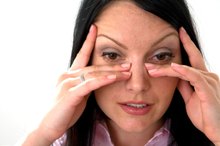4 Possible Causes of Aching Ears and Headaches
Getting through the work day is challenging when you're dealing with aching ears and headaches. These symptoms generally point to medical conditions involving one or more structures in your head, such as your ears, sinuses or upper jaw.
If you are experiencing serious medical symptoms, seek emergency treatment immediately.
"Migraines very often are the cause of an aching ear and headaches," notes Lawrence Lustig, MD, otolaryngologist-in-chief at NewYork-Presbyterian/Columbia University Medical Center in New York City. But if there's unexplained pain in the ears or head region, you'll likely require an MRI or CT scan to get at the root cause, he adds.
We'll explore a few common causes below, but keep in mind that an accurate diagnosis is the key to resolving your pain, so you should check in with your doctor to determine the best course of treatment.
1. Ear Infection
You might think that middle ear infections usually affect young children, but they also occur in adolescents and adults. Typical symptoms include an earache with pressure or a feeling of fullness as well as reduced hearing in the affected ear.
"To ease the pain and open up your eustachian tube (the small conduit between the middle ear and the back of the throat), an over-the-counter medication or steroidal nasal spray may be recommended," says Dr. Lustig. (Some ear infections may also require antibiotics.)
Adolescents and adults with a middle ear infection, also known as otitis media, also sometimes report a headache, but this tends to occur more frequently when the infection spreads to the bone behind the ear. While serious, this complication is rare.
Read more: How to Sleep With Ear Infections
- You might think that middle ear infections usually affect young children, but they also occur in adolescents and adults.
- To ease the pain and open up your eustachian tube (the small conduit between the middle ear and the back of the throat), an over-the-counter medication or steroidal nasal spray may be recommended," says Dr. Lustig.
- (
2. Sinusitis
5 Things That Cause Pain Behind the Ear and Down the Neck
Learn More
When tissue lining the sinuses (hollows in the bones around the nose and head) becomes inflamed, it's called sinusitis. Common causes include a recent head cold and nasal allergies, according to MedlinePlus 5. Headache often accompanies sinusitis due to increased sinus pressure. This occurs when mucus accumulates in the sinuses and cannot drain properly.
The inflammation-induced tissue swelling in the sinuses that occurs with sinusitis frequently extends into the nose and often involves the eustachian tube. This tube can serve as a route of infection into the middle ear, causing ear pain. In the absence of infection, blockage of the opening of the eustachian tube in the nose due to tissue swelling can also lead to ear pain.
"Sinusitis may be either viral or bacterial, though it often starts as a viral process," notes Dr. Lustig. One quick way to tell the difference? If you have green or yellowish discharge, the case is more than likely bacterial in nature.
Treatment for sinusitis is often a decongestant or antihistamine, though if allergies are behind the discomfort, those are treated, too. "Surgery is also a possibility, to enlarge the sinus openings and prevent further cases of sinusitis," says Dr. Lustig.
- When tissue lining the sinuses (hollows in the bones around the nose and head) becomes inflamed, it's called sinusitis.
- In the absence of infection, blockage of the opening of the eustachian tube in the nose due to tissue swelling can also lead to ear pain. "
3. Temporomandibular Joint Disorder
The temporomandibular joints join the upper jaw to the skull in front of the ears. Temporomandibular joint (TMJ) disorders affect approximately 15 percent of adults, according to an article published in the March 2015 issue of American Family Physician 24.
Symptoms of TMJ disorders include 4:
- Jaw pain and/or impaired function
- Earaches
- Headaches
- Facial pain
A case of TMJ can develop in those who have arthritis, an injury to the jaw or if you're prone to clenching or grinding your teeth while you sleep, according to the Mayo Clinic 46.
To treat a case of TMJ, Dr. Lustig suggests warm compresses and OTC medications like Advil or Motrin. Wearing a mouth guard at night can also prevent teeth from clashing together and ease the pain of TMJ.
Read more: Exercises to Relax Jaw Muscles
- The temporomandibular joints join the upper jaw to the skull in front of the ears.
- Symptoms of TMJ disorders include 4: * Jaw pain and/or impaired function
* Earaches * Headaches * Facial pain A case of TMJ can develop in those who have arthritis, an injury to the jaw or if you're prone to clenching or grinding your teeth while you sleep, according to the Mayo Clinic.
4. Upper Spinal Disorders
About Trigeminal Neuralgia & Ear Pain
Learn More
Arthritis and other disorders affecting the bones of the uppermost spine at the base of the skull can cause both headaches and earaches. The pain usually arises due to the compression of nerves as they exit the spinal cord. Headaches due to this cause usually occur at the back of the head, while ear pain can occur in one or both ears. Eye pain might also crop up, along with a decreased ability to move the head and/or neck normally.
Arthritis symptoms also typically include stiffness, swelling and redness in the affected area, according to the Mayo Clinic 46. Treatment depends on the type of arthritis, so be sure to consult with your doctor if you suspect you're affected by this condition.
- Arthritis and other disorders affecting the bones of the uppermost spine at the base of the skull can cause both headaches and earaches.
- Headaches due to this cause usually occur at the back of the head, while ear pain can occur in one or both ears.
Other Considerations, Warnings and Precautions
The conditions discussed represent the leading causes of the paired symptoms of headache and earache. However, other less common ailments might also trigger these symptoms. See your doctor if you experience coexisting head and ear pain, especially if these symptoms persist for more than a few days.
Contact your doctor right away or seek urgent medical care if your symptoms are accompanied by any warning signs or symptoms, including:
- Fever or chills
- Severe or worsening headache
- Visual changes
- Sudden neck stiffness
- Confusion, agitation, drowsiness or other mental changes
- Dizziness or a spinning sensation
- Nausea with or without vomiting
- The conditions discussed represent the leading causes of the paired symptoms of headache and earache.
- See your doctor if you experience coexisting head and ear pain, especially if these symptoms persist for more than a few days.






